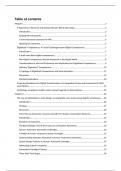Zusammenfassung
Summary Literatuur 1JM50 module 1 t/m 3
- Kurs
- Hochschule
Demerouti, E. (2022). Turn digitalization and automation to a job resource. Applied Psychology, 71, 105-109. Gagné, M., Parker, S. K., Griffin, M. A., Dunlop, P. D., Knight, C., Klonek, F. E., & Parent-Rocheleau, X. (2022). Understanding and shaping the future of work with self-determination ...
[ Mehr anzeigen ]



